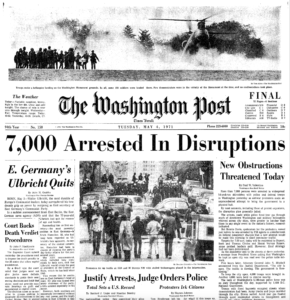Minds of the Movement
An ICNC blog on the people and power of civil resistance
by Hailey Grace SteeleOctober 11, 2017
With recent protests in the United States capturing headlines, it is sometimes easy to lose sight of largescale mobilizations from decades past. Several notable episodes took place during the 1970s, when myriad groups nationwide—and especially in Washington, D.C.—protested U.S. involvement in the Vietnam War. Now is a better moment than any to revisit this period in time, to examine the reactions of onlookers such as journalists and politicians, and to better understand the place civil resistance occupies in our country’s historical trajectory.
The 1971 Spring Peace Offensive
Following several years of mounting discontent about the United States’ role in the war in Vietnam, the spring of 1971 brought with it an onslaught of protesters to the nation’s capital. Over the course of three weeks, some 1,200 Vietnam War veterans, hundreds of thousands of marching demonstrators, and a coalition of more than 100 peace and radical groups, participated in what would come to be known as the Spring Peace Offensive.
Although the organizing groups’ approaches were quite different, their goal was the same: to pressure the U.S. government to end the war in Vietnam.
The Vietnam Veterans Against the War were the first to arrive in the capitol and, despite attempts from the Nixon administration to silence their demonstrations, the veterans and their nonviolent tactics were generally well-received by both politicians and the public. The group’s spokesperson, a graduate of Yale University and former Navy lieutenant, decorated with a Silver Star, a Bronze Star, and three Purple Hearts, was 27-year-old John Kerry (who would later serve in the U.S. Senate, make a strong bid for the U.S. presidency, and become Secretary of State under the Obama administration).
In an article summarizing the variety of tactical approaches employed by the organizations involved in the Spring Peace Offensive, New York Times writer Max Frankel noted the group’s effectiveness:
“The Vietnam veterans who camped outside the Capitol in the week before the big rally, re-enacting some of the horrors of war and peacefully, sometimes even eloquently, bearing witness to their loss of faith in its purposes, made a deep impression on members of Congress and probably gave new weight to the widespread sentiment that the sooner the war ends, the better.”
On Saturday, April 24, 1971, the day after the Vietnam veterans left Washington, the National Peace Action Coalition sponsored a federally approved, one-day march and rally in the streets of D.C. The goal was to attract as many people as possible in order to show U.S. government officials that ordinary citizens were willing to demand an end to the war. While government officials estimated some 200,000 participants took part in the demonstration, the organizers and bystanders claimed at least a half-million people attended the march, securing its place as one of the largest protests ever to occur on U.S. soil.
In response, Max Frankel wrote:
“The great throng that gathered here last weekend had no single purpose. But it was twice as large as anyone expected. It drew praise from the police, as well as the President, for its dignified behavior. It underscored the accelerating disenchantment with the war throughout the country, as recorded in the polls, and it must have served to remind politicians that orderly protest is becoming acceptable in widening circles of adults.”
The Mayday Tribe
 But it was one organizing group—the People’s Coalition for Peace and Justice and one of its smallest divisions, the Mayday Tribe—that would ignite the sharpest confrontation during the 1971 Spring Peace Offensive. Maps were drawn and plans were made to shut down the federal government by blockading the streets leading to the Capitol using cars, dumpsters, and demonstrators’ bodies.
But it was one organizing group—the People’s Coalition for Peace and Justice and one of its smallest divisions, the Mayday Tribe—that would ignite the sharpest confrontation during the 1971 Spring Peace Offensive. Maps were drawn and plans were made to shut down the federal government by blockading the streets leading to the Capitol using cars, dumpsters, and demonstrators’ bodies.
On May 3, 1971, D.C. police and U.S. national guardsmen arrested 7,253 protesters and observers, the most people ever arrested in a single day in U.S. history. It wasn’t long after the demonstration began that police and guardsmen flooded the streets of the city, firing tear gas at crowds gathering and marching as surveillance helicopters whirled overhead.
One city resident recalled that he responded to an appeal on local television for people who could give shelter to students who’d otherwise have to sleep outdoors. But when he went downtown to help, he was swept up into a street full of fleeing protesters who were pepper-gassed in front of the Red Cross headquarters. Those arrested were corralled into makeshift prisons around the city where many were kept overnight—faces pressed against chain-link fences.
Proponents of “direct action," which is not limited to nonviolent tactics, contend that the Mayday Tribe action “helped speed U.S. withdrawal from Vietnam.” But that didn’t happen until the presidency of Gerald Ford, four years later, when the North Vietnamese and Viet Cong overwhelmed South Vietnam, and the remnant of U.S. troops and embassy personnel in Saigon helicoptered to safety. The persistence of protest against the war across more than a decade helped narrow support for the war among Americans. Yet the colossal cost of more than ten years of ground and air war, in lives and resources as well as international support, had likely been more decisive.
“Living in the Truth”
Sifting through lessons about the Vietnam anti-war movement three decades later, Professor David Cortwright of the University of Notre Dame reminded us of an additional factor that undermined Americans’ confidence in the war: It had been based on deception by two presidents about its origin and expansion. President Johnson had exaggerated a naval incident near North Vietnam that triggered a congressional resolution giving him blanket authority to use military force in Southeast Asia—and President Nixon secretly extended U.S. bombing into Cambodia in 1969 and kept it up without informing the public for more than three years.
History often congeals around a common narrative when the truth emerges to discredit the action of governments. The conduct of the Vietnam War ultimately betrayed the confidence of the American people in the credibility of their government, and those who prolonged nonviolent resistance never stopped calling attention to that grievous error.
As the great Czech nonviolent resistance leader Vaclav Havel said, power is developed by those who commit themselves to “living in the truth.” Those who protested the war in Vietnam did that better than those who made the decisions to enlarge and extend the war.
Additional research and writing for this article provided by Jack DuVall.
SaveSaveSaveSave
SaveSave
SaveSave
SaveSave

Hailey Grace Steele
Hailey Grace Steele is a graduate student at the University of Alabama where she is pursuing a master’s degree in journalism. Her research focuses on the effects of individuals’ disposition toward social groups on support for protest, as well as the influence of protest tactics on media frames of dissent. Hailey Grace has worked as an editorial intern for the International Center on Nonviolent Conflict since March 2017.
Read More